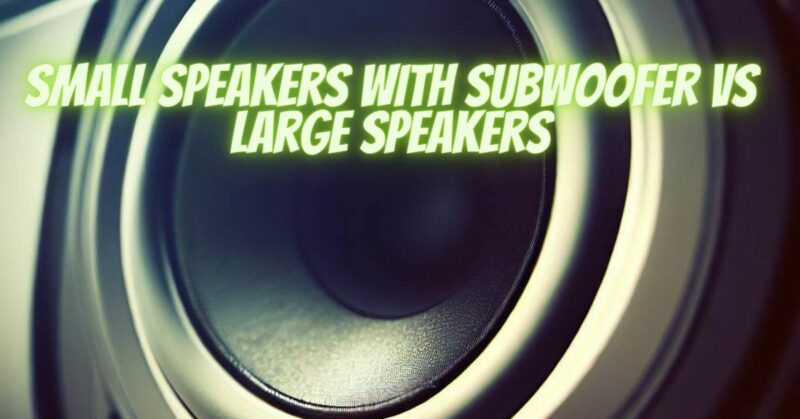When it comes to setting up your audio system, one of the crucial decisions you’ll face is whether to go with small speakers paired with a subwoofer or opt for large speakers that cover a broader frequency range. Both options have their advantages and considerations, and in this article, we’ll explore the differences between these setups to help you make an informed choice.
Small Speakers with Subwoofer: The Compact Powerhouse
Small speakers paired with a subwoofer are a popular choice for many audio enthusiasts. Here’s what you need to know about this setup:
- Sound Quality: Small speakers excel at reproducing mid and high frequencies with clarity and precision. However, they may lack the ability to produce deep, resonant bass on their own.
- Bass Enhancement: The subwoofer is dedicated to handling low-frequency sounds. It complements small speakers by delivering powerful and immersive bass, adding depth to your audio experience.
- Versatility: This setup offers versatility, making it suitable for various listening environments, from home theaters to music studios. Small speakers can be placed conveniently around the room, while the subwoofer can be strategically positioned for optimal bass distribution.
- Space-Efficiency: Small speakers are compact and space-efficient, making them ideal for rooms with limited space. They can be discreetly mounted on walls or placed on bookshelves.
- Clarity: With the subwoofer handling the bass frequencies, small speakers can focus on producing clear and detailed mid and high frequencies. This separation can result in a more balanced and articulate sound.
Large Speakers: All-in-One Powerhouses
Large speakers, on the other hand, are designed to cover a broader frequency range without the need for a separate subwoofer:
- Full-Range Sound: Large speakers are engineered to reproduce a wide range of frequencies, including mid, high, and low frequencies. They are capable of producing substantial bass without the need for additional subwoofers.
- Simplicity: This setup is straightforward and eliminates the need for extra components like subwoofers. It can be an excellent choice for those seeking simplicity and fewer cables.
- Room Filling Sound: Large speakers are capable of delivering room-filling sound, making them suitable for larger spaces and venues.
- Power Handling: They often come with robust power handling capabilities, allowing them to handle high volumes without distortion.
- Tonal Consistency: Large speakers provide a consistent tonal balance across the frequency spectrum, resulting in a cohesive and integrated sound.
Choosing the Right Setup for You
To determine whether small speakers with a subwoofer or large speakers are the better choice, consider the following factors:
- Room Size: The dimensions of your listening space can influence your decision. Small speakers with a subwoofer are versatile and can adapt to smaller rooms, while large speakers may be more suitable for spacious areas.
- Listening Preferences: Think about your preferred music genres and the type of content you consume. If you’re a bass enthusiast or enjoy genres with deep bass, a subwoofer can enhance your experience.
- Aesthetic Considerations: Consider the aesthetics of your space. If you prefer a minimalist look with fewer visible components, large speakers might be the better choice.
- Budget: Evaluate your budget, as small speakers with a subwoofer can be a cost-effective solution, especially for those on a tight budget.
- Sound Quality: Ultimately, prioritize sound quality. Listen to both setups if possible and choose the one that best suits your auditory preferences.
The choice between small speakers with a subwoofer and large speakers depends on your specific needs and preferences. Each setup offers its unique advantages, and the decision should align with your listening environment, musical taste, and aesthetic preferences. Regardless of your choice, the goal is to create an audio experience that brings your music, movies, and games to life with the best possible sound quality.


